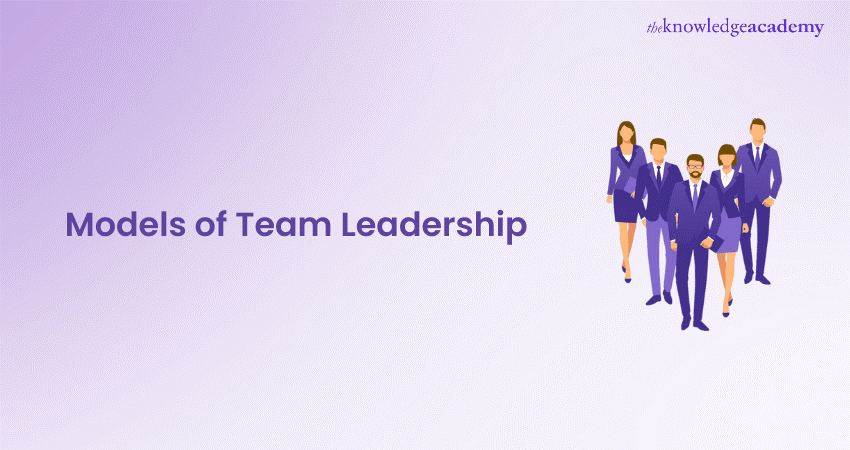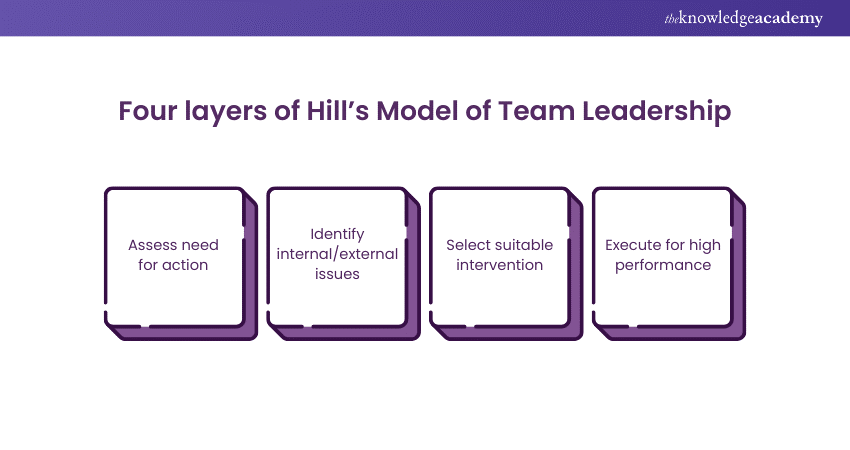We may not have the course you’re looking for. If you enquire or give us a call on 01344203999 and speak to our training experts, we may still be able to help with your training requirements.
Training Outcomes Within Your Budget!
We ensure quality, budget-alignment, and timely delivery by our expert instructors.

Team Leadership is a critical aspect of organisational success, shaping how groups collaborate, innovate, and achieve objectives. Building open communication, trust, and alignment around shared objectives are essential components of successful Team Management. However, without understanding the Models of Leadership, team leaders cannot achieve goals and distribute responsibilities properly.
In this blog, we will delve into the nature of Team Leadership, exploring its significance and practical applications. We'll break down the four-layer Models of Team Leadership, each component from assessing the need for action to executing strategies for high performance.
Table of Contents
1) What is a Team Leadership Model?
2) The four layers of Hill’s Model of Team Leadership
a) Assess the need for action
b) Identify internal/external issues
c) Select suitable intervention
d) Execute the intervention for high-performance
3) Managing a successful team
4) Conclusion
What is a Team Leadership Model?
The Team Leadership Model typically involves clearing goals, roles, and expectations. It encourages open communication, promotes collaboration, provides support and guidance, facilitates conflict resolution, and recognises and rewards team achievements.
The four layers of Hill’s Model of Team Leadership
Here are the four layers of Hill’s Model of Team Leadership. Let’s discuss one by one:

1) Assess the need for action
When there are gaps in performance, communication, conflicts, or changes in the external environment, action may be necessary. Assessing the need for action involves evaluating various factors such as team dynamics, performance, external challenges and organisational goals.
2) Identify internal/external issues
In the Team Leadership Model, both internal and external issues play a significant role in shaping the team's dynamics and performance. Internal issues include conflicts among the team members and lack of clarity in responsibilities. These issues can impede the progress and productivity of the team.
These issues can impede progress and productivity of the team. Addressing these issues requires strong Team Leadership Skills, including clear communication and the ability to encourage a positive team culture.
External factors, including changes in market conditions, technological advancements can impact the team's objectives and strategies. Leaders must adopt to these external factors by realigning goals, reallocating resources.
Unleash your potential as a Leader with our Leadership Courses - sign up today!
3) Select suitable intervention
Three essential intervention functions such as task, relational, and environmental intervention are defined in Hill's Team Leadership Model. Each of these functions is crucial for guiding a team towards success.
Task interventions involve defining goals, improving strategies, and developing skill sets through focused training programmes. Through developing a sense of competence and clarity, leaders allow their teams to address problems with accuracy and effectiveness.
Relational interventions focus on creating a supportive environment while delving into the complex web of team dynamics. Here, instructing people, skilfully handling conflict, and cultivating a constant dedication are all components of effective Leadership. The collective strength and flexibility of a team is strengthened by leaders who support trust and understanding among team members.
Environmental interventions address outside factors that can either facilitate or obstruct progress. Competent leaders concentrate on strategically utilising resources and speaking up for the needs of their team. Through adept direction in external environments, leaders can enhance their team's ability to succeed in the face of external pressures and uncertainties.
Unlock your Leadership potential with our Agile Leadership Training - sign up now!
4) Execute the intervention for high performance
Executing the relevant form of intervention for high performance demands accuracy and strategic alignment. To accomplish goals, leaders must coordinate efforts and make the best use of available resources. To do this, it is necessary to cultivate an environment of excellence and accountability where every team member is fully aware of their responsibilities and may effectively contribute.
Managing a successful team
Managing a successful team requires a delicate balance of task orientation, relational expertise, and environmental awareness. Make your goals clear, improve strategies, and offer specialised training to improve skill sets. Encourage commitment, handle disagreements in a constructive manner, and provide individual coaching to create a supportive atmosphere.
Handle outside influences with skill, making use of networks, fighting for resources, and adjusting to shifting circumstances. Establish a culture of cooperation and accountability by exercising integrity, empathy, and a dedication to ongoing improvement in your Leadership.
Elevate your level of excellence with our Event Management Masterclass!
Conclusion
Today, we delved into various Models of Team Leadership. We looked at how they work and, discussing how to assess needs, identify issues, select interventions, and execute for top-notch performance. The key to leading a strong team is to understand these dynamics. So, take charge and watch your team succeed!
Frequently Asked Questions

Hill's Team Leadership Model is a well-known framework developed by Dr. Susan E. Hill. It describes the fundamental elements and workings of successful Team Leadership.

Ginnett's Team Leadership Model, proposed by Gerald R. Ginnett, is a well-known framework in the field of Team Leadership. It focuses on the teamwork between the leader and the team and the task of achieving successful outcomes. The Model emphasises the importance of Leadership behaviours, team processes, and task characteristics in influencing team effectiveness.

The Knowledge Academy takes global learning to new heights, offering over 30,000 online courses across 490+ locations in 220 countries. This expansive reach ensures accessibility and convenience for learners worldwide.
Alongside our diverse Online Course Catalogue, encompassing 17 major categories, we go the extra mile by providing a plethora of free educational Online Resources like News updates, Blogs, videos, webinars, and interview questions. Tailoring learning experiences further, professionals can maximise value with customisable Course Bundles of TKA.

The Knowledge Academy’s Knowledge Pass, a prepaid voucher, adds another layer of flexibility, allowing course bookings over a 12-month period. Join us on a journey where education knows no bounds.

The Knowledge Academy offers various Leadership Courses, including Leadership Skills Training, Growth Mindset Training and Successful People Management and Team Leadership. These courses cater to different skill levels, providing comprehensive insights into Leadership Qualities.
Our Business Skills Blogs cover a range of topics related to Leadership, offering valuable resources, best practices, and industry insights. Whether you are a beginner or looking to advance your Leadership Skills, The Knowledge Academy's diverse courses and informative blogs have you covered.
Upcoming Business Skills Resources Batches & Dates
Date
 Leadership Skills Training
Leadership Skills Training
Fri 31st May 2024
Fri 28th Jun 2024
Fri 26th Jul 2024
Fri 30th Aug 2024
Fri 27th Sep 2024
Fri 25th Oct 2024
Fri 29th Nov 2024
Fri 27th Dec 2024







 Top Rated Course
Top Rated Course



 If you wish to make any changes to your course, please
If you wish to make any changes to your course, please


